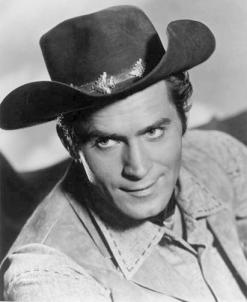SYNOPSIS
The
behind-the-scenes story of this series was fully as interesting as what appeared
on the screen. Probably no
series in TV history has undergone so much production turmoil and absorbed and
spun-off as many other series as did Cheyenne.
The on-screen story was simple
enough. Cheyenne
Bodie was a tall, strapping Western adventurer in the days following the Civil War - he was
6' 7", or 6' 5", or 6' 8", depending on the press release - and a mean hombre. He drifted from job to job, encountering
plenty of
villains, beautiful girls and gunfights. In one episode, he could be seen as the
foreman on a ranch, in another as trail scout for a wagon train, in another as a
recently deputized lawman. The
show was lavishly produced, movie-style, by Warner Bros., but the attraction was
obviously Clint Walker himself. He had a sidekick, Smitty, for the first
season, but after that, he worked alone.
Cheyenne
was first seen as one of three rotating elements of Warner
Bros. Presents, the studio's
first venture into TV, and quickly emerged as the most popular of the the three. Hour-long Westerns were difficult to produce on a once-a-week basis,
however, so the program continued to alternate with other series, first Conflict (1956-1957) and then
Sugarfoot (1957-1959).
In fact, Clint Walker's Cheyenne was seldom seen on an every-week basis
at any time during its original run.
In
1958, the brooding fighter of the screen walked out on Warner Bros., after they
refused to release him from some of the more stringent requirements of his
contract, which he had signed before Cheyenne
became a hit. Among other things, Walker did not want to have to kick back 50
percent of all
personal appearance fees to the studio, wanted
higher payment for reruns, and wanted permission to make records for labels
other than Warner's own. Stripped of its star, the studio nevertheless refused to
give an inch and continued the series under the name Cheyenne, with an unknown actor
named Ty Hardin in the
leading role, which was now that of Bronco Layne. Walker meanwhile, was legally
prevented from working anywhere.
In
early 1959, Walker and the studio finally came to terms, and Walker returned to the
series. Ty Hardin continued in a series of his own called
Bronco.
Clint Walker was obviously not happy with the settlement, for although the pot had been
sweetened somewhat he felt he had simply worn out the Cheyenne character and was becoming
typecast. But the program was in the top 20, and Warner Bros. was not about to
let him go. "I am like a caged animal," he complained to reporters.
For part
of the 1959-1960 season, Cheyenne
alternated with Shirley
Temple's Storybook. Then for
1960-1961, Cheyenne
became The Cheyenne Show,
a rotating anthology in which Walker was seen on a majority of weeks,
interspersed with episodes of Ty Hardin as Bronco
and Will Hutchins as Sugarfoot.
In 1961-1962, Sugarfoot
was dropped and only Cheyenne
and Bronco
were seen. Finally, in the fall of 1962, for the last three months, the series consisted of
episodes of Walker's Cheyenne alone.
Reruns of Cheyenne episodes were also seen during the summer of 1963.
Cheyenne
was based, rather loosely, on 1947 movie of the same name that starred Dennis Morgan.






